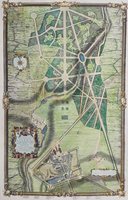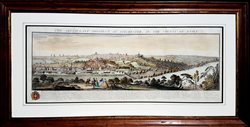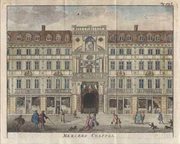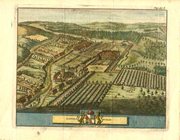Jacques Rigaud (1680-1754), was one of the earliest prominent architectural and topographical artists in France. Over the years he engraved around two hundred topographical prints. His importance as an engraver was undoubtedly assured after his dedication of a series of his engravings to Jean-Philippe d’Orleans (Chevalier d’Orleans), who was the illegitimate son of Philippe d’Orleans, who in turn was the nephew and son-in-law of Louis XIV, Regent of France. Rigaud engraved the
magnificent chateau of the Royal Residence at Choisy, and a fabulous
Versailles garden-room with a grand fountain centrepiece circa 1730.
Apparently

invited to England by the head royal gardener, Charles Bridgeman, Rigaud also illustrated English royal residences – the most comprehensive of these were his perspective views of the most celebrated landscape garden at that period in England, Lord Cobham’s Stowe in Buckinghamshire, designed by Charles Bridgeman. (The gardener who followed in Bridgeman’s footsteps at Stowe was the famous landscape designer, Capability Brown.) AntiquePrintClub.com, under Decorator Art, has a few rare hand-coloured reproduction prints of Rigaud’s engravings of
Bridgeman’s Stowe (with his complete landscape design).
Travelling throughout England and Wales over 35 years during the warmer months, Yorkshire brothers, draughtsmen and engravers Samuel Buck (1696-1779) and Nathaniel Buck (active 1724-1759) sketched prominent landmarks. They published 423 engravings of ancient monasteries, abbeys, castles and ruins, and their engraved prints were sold, grouped into counties, to a clientele of antiquarians, nobility, gentry and clergy. Prominent 18th century London print and map seller, Robert Sayer, commented of Bucks’ patrons that a “more respectable list of Subscribers is rarely seen”. Illustrating the buildings and ruins on the estates of their elite and exclusive clientele, would undoubtedly have defrayed the Bucks’ travel costs.

While tourism was undoubtedly promoted by these engravings, the copperplate-engraved views, published in 1732 as
A Prospect of Britain. The Town Panoramas of Samuel and Nathaniel Buck brought the Bucks brothers a much higher profile. Many of these large and elegant engravings included fashionably attired people in the foreground, and a coat of arms and text description at their base. Much coveted, Bucks’ large panoramas are rarely seen today in fine condition. Antique Print Club have framed a few.

After training in Amsterdam as an engraver, in 1689 Johannes Kip (1653-1722), travelled to England looking for work. From a family of Netherland artists, Leendert Knyff also moved to London around this time. At the end of the 17th century, to provide financial support for his work, Knyff promoted a scheme to subscribers for their contributions for illustrations of their house and grounds with their coat of arms. He began working with Kip but returned to the Netherlands in 1707 after failing to acquire sufficient funds to subsidise their work. From Knyff’s drawings, Kip’s
Britain Illustrata or Views of Several of the Queens Palaces and the Principal Seats of the Nobility and Gentry of Great Britain “Curiously Engraven on 80 Copper Plates” was published in London in 1707. Comprehensive overviews of the estates of the wealthy were unusual birds’-eye aspects which were achieved by using surveying and mapping methods.

Owners coveted engravings showing the extent of their land and formal 18
th century landscaping. Kip’s large engravings of English country estates were re-engraved by James Beeverell and published in 1727 by prominent mapmaker of Leyden, Pieter van der Aa. Beeverell’s gorgeous little engravings of important estates with title and coat of arms below, had two vertical folds for a pocket edition of
Estates of Great Britain and Ireland, Useful and Curious Works.
The style of engravings of topographical scenes varied considerably - according to not only the skill of the artists and engravers but also to their financial capacities. The promotion achieved by a good image of a region or building can never be disputed, but antique prints also provide a wonderful selection of fine rare artwork today...
Antique Prints/Architecture/Landscaping.